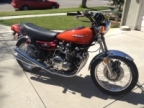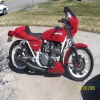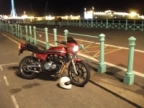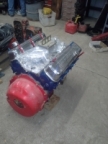Cylinder Hone and ring seating
- Yorkie
-
 Topic Author
Topic Author
- Offline
- User
-

Registered
- Posts: 41
- Thanks: 1
Cylinder Hone and ring seating
03 Dec 2014 08:58
The monkey that threw together the motor in my Z1 put new pistons in but did not hone the cylinder bores. The pistons have approximately 20 miles on them. I was wondering if I hone the bores with these rings with they seal OK or do I need to replace the rings?
'72 Z1
Please Log in or Create an account to join the conversation.
- Nessism
-
- Offline
- Sustaining Member
-

Registered
- Posts: 7748
- Thanks: 3138
Re: Cylinder Hone and ring seating
03 Dec 2014 09:05
Considering the cost of rings, I'd throw a hone on it and see what happens. With a used cylinder a 240 grit bottle brush hone seems to work well. During break-in use the throttle liberally to apply pressure on the rings and help them seat. An urban driving schedule where you accelerate briskly away from stops is about right. Whatever you do don't baby the engine.
Ed
Carb O-ring Kits : www.kzrider.com/forum/3-carburetor/61807...-o-ring-kits?start=0
www.kzrider.com/forum/faq-wiki/618026-new-owner-things-to-know
1981 KZ750E2
www.kzrider.com/forum/11-projects/604901...z750e-project-thread
Carb O-ring Kits : www.kzrider.com/forum/3-carburetor/61807...-o-ring-kits?start=0
www.kzrider.com/forum/faq-wiki/618026-new-owner-things-to-know
1981 KZ750E2
www.kzrider.com/forum/11-projects/604901...z750e-project-thread
The following user(s) said Thank You: Yorkie
Please Log in or Create an account to join the conversation.
- baldy110
-

- Offline
- User
-

Registered
- Posts: 2272
- Thanks: 512
Re: Cylinder Hone and ring seating
03 Dec 2014 09:17
You will be fine simply honing the cylinders and re-using your pistons and rings. Make sure your ring gaps are set also, you never know what the guy before you did so check them yourself.
The following user(s) said Thank You: PLUMMEN, Yorkie
Please Log in or Create an account to join the conversation.
- Tyrell Corp
-

- Offline
- User
-

Registered
- "You were made as well as we could make you"
- Posts: 1650
- Thanks: 261
Re: Cylinder Hone and ring seating
03 Dec 2014 12:10Nessism wrote: Considering the cost of rings, I'd throw a hone on it and see what happens. With a used cylinder a 240 grit bottle brush hone seems to work well. During break-in use the throttle liberally to apply pressure on the rings and help them seat. An urban driving schedule where you accelerate briskly away from stops is about right. Whatever you do don't baby the engine.
Yes, also when the throttle is snapped shut on the over-run on engine braking, that vacuum pulls the rings in the other direction.
I've never had a new car or bike in my life, I'd sooner waste it on hookers and booze, but i did a V8 Triumph Stag car engine and it was very noticeable how the engine loosened up nicely over the first 1000 miles.
Kawasaki 550/750 owner's manual recommends IIRC 4k rpm for 500 miles, 6k rpm for 1000 miles. Personally i think it is more about load on the engine. Being too careful can cause probelems too.
OP I'd just run it and see how it turns out over the next few hundred miles.
1980 Gpz550 D1, 1981 GPz550 D1. 1982 GPz750R1. 1983 z1000R R2. all four aces
Please Log in or Create an account to join the conversation.
- PLUMMEN
-

- Offline
- User
-

Registered
- Posts: 7986
- Thanks: 104
Re: Cylinder Hone and ring seating
03 Dec 2014 12:47
Dont forget to change oil/filter after about 50 miles, check valves around 500 miles.
Still recovering,some days are better than others.
Please Log in or Create an account to join the conversation.
- SWest
-

- Offline
- Sustaining Member
-

Registered
- 10 22 2014
- Posts: 23382
- Thanks: 2902
Re: Cylinder Hone and ring seating
03 Dec 2014 14:03 - 03 Dec 2014 14:04
I don't agree with some of the posters. I bought my Z1b new in 75. I broke it in per recommendations. Not over 4000 rpm's for 1000 miles. Never grab a hand full from a standing start. Do pull away strongly and use the engine for braking. This is to help "seat" the rings. I would suggest new rings if possible. Check the end gap with the rings in the cylinders one by one. The gap should be .002-.004. Make sure you have a 45% cross hatch in the cylinders. Check the cylinder/piston gap in three places. Top, middle and bottom. If the gap is excessive, all bets are off and ride the piss out of it, burn oil, foul plugs and get ready to do it all over again.
Did you?
1 install new valve guide seals
2 install or lap the valves
3 install new cam chain guide and rollers
Missing one or more of these things can lead to a F*cked up day.
Steve
Did you?
1 install new valve guide seals
2 install or lap the valves
3 install new cam chain guide and rollers
Missing one or more of these things can lead to a F*cked up day.
Steve
Attachment Bossieandthegirls.jpg not found
Z1b1000 1975 Z1b
kzrider.com/forum/11-projects/598262-kz-...-will-it-live#672882
kzrider.com/forum/2-engine/597654-poser?start=240#704229
kzrider.com/forum/11-projects/598262-kz-...-will-it-live#672882
kzrider.com/forum/2-engine/597654-poser?start=240#704229
Attachments:
Last edit: 03 Dec 2014 14:04 by SWest.
Please Log in or Create an account to join the conversation.
- Nessism
-
- Offline
- Sustaining Member
-

Registered
- Posts: 7748
- Thanks: 3138
Re: Cylinder Hone and ring seating
03 Dec 2014 17:06 - 03 Dec 2014 17:07
This is a good read about ring break-in...
www.mototuneusa.com/break_in_secrets.htm
Personally, I think it's a little extreme, but no way I'd baby the engine like the Kawasaki procedure suggests. I think that procedure has it's root in people that don't know how to ride. Can you imagine the liability for Kawasaki if they instructed new KZ1000 owners to twist the throttle aggressively from mile one to seat the rings?
Personally, I think it's a little extreme, but no way I'd baby the engine like the Kawasaki procedure suggests. I think that procedure has it's root in people that don't know how to ride. Can you imagine the liability for Kawasaki if they instructed new KZ1000 owners to twist the throttle aggressively from mile one to seat the rings?
Ed
Carb O-ring Kits : www.kzrider.com/forum/3-carburetor/61807...-o-ring-kits?start=0
www.kzrider.com/forum/faq-wiki/618026-new-owner-things-to-know
1981 KZ750E2
www.kzrider.com/forum/11-projects/604901...z750e-project-thread
Carb O-ring Kits : www.kzrider.com/forum/3-carburetor/61807...-o-ring-kits?start=0
www.kzrider.com/forum/faq-wiki/618026-new-owner-things-to-know
1981 KZ750E2
www.kzrider.com/forum/11-projects/604901...z750e-project-thread
Last edit: 03 Dec 2014 17:07 by Nessism.
Please Log in or Create an account to join the conversation.
- bountyhunter
-

- Offline
- User
-

Registered
- Posts: 7245
- Thanks: 338
Re: Cylinder Hone and ring seating
03 Dec 2014 17:42 - 03 Dec 2014 17:57Every source I have ever read says you need about .003" - .004" end gap per inch of bore diameter. It can not be a fixed value because it is proportional to the linear length of the ring since it has to allow for it's total expansion due to temp increase. It has to be related to length which is defined by diameter.swest wrote: Check the end gap with the rings in the cylinders one by one. The gap should be .002-.004.
1979 KZ-750 Twin
Last edit: 03 Dec 2014 17:57 by bountyhunter.
Please Log in or Create an account to join the conversation.
- bountyhunter
-

- Offline
- User
-

Registered
- Posts: 7245
- Thanks: 338
Re: Cylinder Hone and ring seating
03 Dec 2014 17:49 - 03 Dec 2014 17:54Well, somebody is certainly full of themselves. I, and probably 99% of bike owners, used the "owner's manual" method and never had a problem. I personally got about 80k miles on my first set of pistons and rings, had excellent compression and didn't blow a drop of oil so I don't know what else one can expect from rings. I also inspected the cylinder walls at rebuild and they looked good to me. Bored it out .010 and installed the next larger pistons/rings and did the same thing. Perfect compression, zero oil usage again.The results are always the same... a dramatic increase in power at all RPMs. In addition, many professional mechanics have disassembled engines that have used this method, to find that the condition of the engine is much better than when the owner's manual break-in method has been used.
Personally, I don't think proper break in is as complicated as some would claim. If it was, a lot more bikes would be spraying oil out the tailpipe.
1979 KZ-750 Twin
Last edit: 03 Dec 2014 17:54 by bountyhunter.
Please Log in or Create an account to join the conversation.
- bountyhunter
-

- Offline
- User
-

Registered
- Posts: 7245
- Thanks: 338
Re: Cylinder Hone and ring seating
03 Dec 2014 18:06 - 03 Dec 2014 18:14
The problem is, some of the info being peddled just isn't true:
Here's some things I do know to be true:
The steel in rings is much harder than the cylinder wall. That's why the rings pretty readily cut the cross hatch pattern down and seal by "forming" the cylinder to the necessary shape.
How well did my rings end up sealing? Aside from running better than new, and zero oil usage, I did a compression check from stone cold (dry) sat overnight versus fully hot after running and saw a variation of less than 5 PSI.
I am not saying that winding it up a bit will necessarily keep the rings from seating, but I know for a fact it is not necessary to get good seating and the "20 mile" thing is pure BS.
TO ADD: I believe the reason that they advise against wide open throttle during break in: when the rings are working against the cross hatched surface, full pressure can get the edge of the ring to dig into the cylinder wall and score it. After full break in, the square face of the ring is working against the flat cylinder wall so it is less likely to be able to turn enough to dig in an edge. Like I said, might not damage the engine but probably not good to do it a lot during break in. I have been working on engines starting back about 1967 and the break in advice has always been the same: keep the revs down, don't heavy foot the throttle too much, but do run the revs gently up and then let the throttle close and decelerate to get the rings to press against the cylinder walls.
How Do Rings Seal Against Tremendous Combustion Pressure ??
From the actual gas pressure itself !! It passes over the top of the ring, and gets behind it to force it outward against the cylinder wall. The problem is that new rings are far from perfect and they must be worn in quite a bit in order to completely seal all the way around the bore. If the gas pressure is strong enough during the engine's first miles of operation (open that throttle !!!), then the entire ring will wear into
the cylinder surface, to seal the combustion pressure as well as possible.
The Problem With "Easy Break In" ...
The honed crosshatch pattern in the cylinder bore acts like a file to allow the rings to wear. The rings quickly wear down the "peaks" of this roughness, regardless of how hard the engine is run.
There's a very small window of opportunity to get the rings to seal really well ... the first 20 miles !!
If the rings aren't forced against the walls soon enough, they'll use up the roughness before they fully seat. Once that happens there is no solution but to re hone the cylinders, install new rings and start over again.
Fortunately, most new sportbike owners can't resist the urge to "open it up" once or twice,
which is why more engines don't have this problem !!
Here's some things I do know to be true:
The steel in rings is much harder than the cylinder wall. That's why the rings pretty readily cut the cross hatch pattern down and seal by "forming" the cylinder to the necessary shape.
Baloney. On my last rebuild, I fired it up at about 9PM on a sunday night and all I had the time to do was drive around my housing area for about 20 minutes at low speed. I then retorqued the head the next day and rode it like a new bike (Keep revs below about 4K, don't open throttle more than about 1/2).There's a very small window of opportunity to get the rings to seal really well ... the first 20 miles !!
How well did my rings end up sealing? Aside from running better than new, and zero oil usage, I did a compression check from stone cold (dry) sat overnight versus fully hot after running and saw a variation of less than 5 PSI.
I am not saying that winding it up a bit will necessarily keep the rings from seating, but I know for a fact it is not necessary to get good seating and the "20 mile" thing is pure BS.
TO ADD: I believe the reason that they advise against wide open throttle during break in: when the rings are working against the cross hatched surface, full pressure can get the edge of the ring to dig into the cylinder wall and score it. After full break in, the square face of the ring is working against the flat cylinder wall so it is less likely to be able to turn enough to dig in an edge. Like I said, might not damage the engine but probably not good to do it a lot during break in. I have been working on engines starting back about 1967 and the break in advice has always been the same: keep the revs down, don't heavy foot the throttle too much, but do run the revs gently up and then let the throttle close and decelerate to get the rings to press against the cylinder walls.
1979 KZ-750 Twin
Last edit: 03 Dec 2014 18:14 by bountyhunter.
Please Log in or Create an account to join the conversation.
- 650ed
-

- Offline
- User
-

Registered
- Posts: 15333
- Thanks: 2833
Re: Cylinder Hone and ring seating
03 Dec 2014 18:12bountyhunter wrote:Well, somebody is certainly full of themselves. I, and probably 99% of bike owners, used the "owner's manual" method and never had a problem. I personally got about 80k miles on my first set of pistons and rings, had excellent compression and didn't blow a drop of oil so I don't know what else one can expect from rings. I also inspected the cylinder walls at rebuild and they looked good to me. Bored it out .010 and installed the next larger pistons/rings and did the same thing. Perfect compression, zero oil usage again.The results are always the same... a dramatic increase in power at all RPMs. In addition, many professional mechanics have disassembled engines that have used this method, to find that the condition of the engine is much better than when the owner's manual break-in method has been used.
Personally, I don't think proper break in is as complicated as some would claim. If it was, a lot more bikes would be spraying oil out the tailpipe.
+1 !!!
I suppose he would consider the following "Break" in method to add plenty of power at all rpm. :laugh: Ed
1977 KZ650-C1 Original Owner - Stock (with additional invisible FIAMM horn)
Please Log in or Create an account to join the conversation.
- SWest
-

- Offline
- Sustaining Member
-

Registered
- 10 22 2014
- Posts: 23382
- Thanks: 2902
Re: Cylinder Hone and ring seating
03 Dec 2014 18:13
I stand corrected. I just went to my Wiseco chart and it says,
Stock
Top ring.0050"
2nd ring,0055"
Oil rails min. of .010"
"The gap on the second ring should be larger than the top ring end gap, this will help to reduce top ring flutter or lifting."
High performance street/strip, .0045,.0055
Stock
Top ring.0050"
2nd ring,0055"
Oil rails min. of .010"
"The gap on the second ring should be larger than the top ring end gap, this will help to reduce top ring flutter or lifting."
High performance street/strip, .0045,.0055
Z1b1000 1975 Z1b
kzrider.com/forum/11-projects/598262-kz-...-will-it-live#672882
kzrider.com/forum/2-engine/597654-poser?start=240#704229
kzrider.com/forum/11-projects/598262-kz-...-will-it-live#672882
kzrider.com/forum/2-engine/597654-poser?start=240#704229
Please Log in or Create an account to join the conversation.
Moderators: Street Fighter LTD
